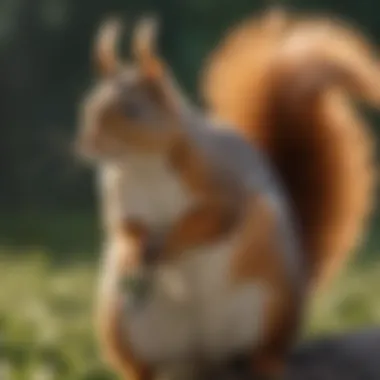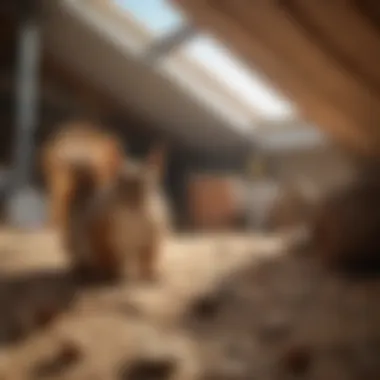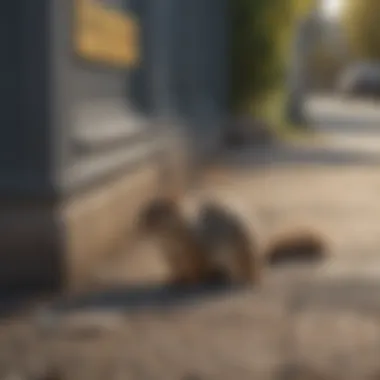Can Professional Pest Control Services Effectively Eliminate Squirrels?


Preventive Pest Control Strategies
When it comes to pest control, prevention is key. Protecting your house from unwanted intruders like squirrels requires a combination of strategies starting from the exterior. Begin with sealing cracks found around windows, doors, and utility penetrations. This meticulous process helps in preventing these curious critters from finding their way into your home. Clearing debris such as loose branches and leaves that can serve as hiding spots is essential. Additionally, taking preventive measures to stop pests from entering, like installing wire mesh on vents and chimneys, can significantly reduce the risk of squirrel infestations.
In terms of yard maintenance, it's crucial to establish regular routines to keep it pest-free. This includes trimming vegetation away from the house and removing standing water that may attract pests. Indoor cleanliness plays a vital role in pest prevention as well. Adopt expert cleaning tips and techniques to eliminate potential hiding spots for pests. Maintaining a pest-resistant indoor environment entails proper food storage, prompt garbage disposal, and keeping surfaces clean.
Speaking of garbage disposal, efficient waste management is key to discouraging pest activity. Ensure trash bins are tightly sealed to prevent easy access for scavenging pests. Proper garbage disposal not only maintains the cleanliness of your property but also effectively deters unwelcome critters.
Aside from these strategies, various other preventive measures can be taken to safeguard your home against squirrel invasions, such as using natural repellents, setting up barriers, and establishing regular pest inspections.
Introduction
Pest control plays a crucial role in addressing squirrel infestations, especially in residential and commercial settings. As these furry intruders can cause significant damage, understanding effective pest control methods is paramount. This article aims to explore different strategies and techniques used by professionals to combat squirrel invasions successfully.
Understanding Squirrel Infestations
Behavioral Patterns of Squirrels
Squirrels exhibit specific behavioral patterns that contribute to their invasiveness. Their agility and ability to climb with ease make them a challenging pest to deal with. Understanding these behavioral traits is essential in formulating effective pest control strategies. Despite their cute appearance, squirrels have a knack for causing chaos in residential areas.
Damage Caused by Squirrels
The damage caused by squirrels can be extensive and costly. From gnawing on wood and wires to creating nests in attics, their activities can compromise the structural integrity of a property. This damage underscores the urgency of addressing squirrel infestations promptly to prevent further harm.
Common Entry Points for Squirrels
Squirrels commonly gain entry into buildings through vulnerable points such as gaps in roofs, vents, and chimneys. Identifying and sealing these entry points is crucial in preventing future infestations. By understanding where squirrels are likely to enter, homeowners can take proactive measures to fortify these weak spots.
The Role of Pest Control
Overview of Pest Control Methods


Pest control methods vary in their approach to managing squirrel infestations. From exclusion techniques to trapping and removal, professionals employ a range of strategies to address the issue. Choosing the right method depends on factors like the severity of the infestation and the property layout.
Legal Considerations in Squirrel Removal
When engaging in squirrel removal, it is essential to consider the legal guidelines governing wildlife management. Some species of squirrels may be protected, requiring humane trapping and relocation practices. Adhering to these regulations ensures that pest control efforts are conducted ethically and lawfully.
Assessment of Squirrel Infestations
In this article, the segment on Assessment of Squirrel Infestations plays a crucial role in outlining the necessary steps to effectively tackle squirrel issues. By undertaking a thorough inspection and evaluation, individuals can understand the extent of the infestation and determine the appropriate course of action. This assessment stage serves as the foundation for implementing targeted pest control measures, enabling homeowners and property managers to address squirrel problems proactively. Additionally, by identifying the signs of infestation and conducting a risk assessment, individuals can safeguard their living spaces from potential health risks and structural damage associated with squirrel presence.
Inspection and Identification
Signs of Squirrel Infestations
Exploring the Signs of Squirrel Infestations is pivotal in detecting the covert presence of these rodents within a premises. The key characteristic of recognizing squirrel infestations lies in observing specific indicators such as gnaw marks on wood, droppings, and the scent of urine. These signs are essential in pinpointing areas where squirrels have been active, aiding in the process of determining the extent of the infestation. Although these signs may not always be evident, their identification can significantly contribute to devising effective pest control strategies to combat squirrel invasions.
Determining the Scope of the Infestation
Determining the Scope of the Infestation involves assessing the magnitude and reach of squirrel presence within a property. This crucial step provides insights into the level of infestation, potential entry points, and areas of concern. By gauging the spread of squirrel activity, individuals can strategize and implement pest control measures tailored to target specific areas. Understanding the scope of the infestation allows for a focused and efficient approach to squirrel removal, minimizing the risks of recurring infestations and ensuring comprehensive eradication.
Risk Assessment
Health Risks Associated with Squirrel Infestations
Exploring the Health Risks Associated with Squirrel Infestations sheds light on the potential dangers posed by these rodents. The key characteristic lies in understanding the various diseases squirrels can transmit to humans, such as leptospirosis and salmonellosis. By recognizing these health risks, individuals can take preventive measures to safeguard their well-being and that of their families. Implementing proper pest control strategies can mitigate the health hazards associated with squirrel infestations, creating a safer living environment.
Structural Damage Potential
Considering the Structural Damage Potential caused by squirrel infestations is essential in preserving the integrity of a property. The key characteristic involves recognizing the destructive behavior of squirrels, including gnawing on electrical wires, insulation, and wooden structures. This damage not only poses safety risks but also leads to costly repairs. By evaluating the structural implications of squirrel infestations, individuals can prioritize intervention strategies that protect their property from extensive harm, ensuring long-term structural stability.
Pest Control Strategies for Squirrels


Pest control strategies for squirrels play a vital role in effectively managing and eradicating squirrel infestations. These strategies encompass a range of methods and approaches utilized by pest control professionals to tackle squirrel problems in residential and commercial settings. By employing a combination of exclusion, trapping, and deterrent techniques, pest control experts aim to not only remove existing squirrels but also prevent future infestations. Understanding and implementing these strategies are essential for successful squirrel infestation management.
Exclusion Techniques
Sealing Entry Points
Sealing entry points is a crucial aspect of squirrel pest control strategies. By identifying and sealing off potential entry points such as gaps in roofs, vents, and walls, property owners can effectively prevent squirrels from accessing indoor spaces. This method serves as a fundamental proactive measure, addressing the root cause of infestations by denying squirrels entry into buildings. The key characteristic of sealing entry points lies in its ability to provide long-term protection against squirrel intrusions, making it a popular and effective choice for squirrel control. Despite its efficacy, one drawback of sealing entry points is the need for thorough inspection and maintenance to ensure all gaps are adequately sealed, requiring both time and effort.
Installing Preventative Measures
Installing preventative measures is another essential component of squirrel pest control strategies. This involves setting up barriers or deterrents around properties to deter squirrels from approaching or entering the premises. By utilizing physical barriers like fencing or netting, property owners can create a protective boundary that hinders squirrel access. One of the key advantages of installing preventative measures is its capacity to offer continuous protection against squirrel incursions, reducing the likelihood of future infestations. However, a potential disadvantage of this method is the initial cost and effort required to set up these barriers, which may deter some property owners from implementing preventative measures.
Trapping and Removal
Humane Trapping Methods
Humane trapping methods are a humane and effective way to capture and remove squirrels from properties. This method involves using live traps that safely capture squirrels without causing harm, allowing for their later release in suitable habitats. The key characteristic of humane trapping methods is their ethical approach to pest control, emphasizing the importance of animal welfare while addressing squirrel infestations. This method is a popular choice for property owners seeking a compassionate solution to squirrel problems. However, one potential disadvantage of humane trapping methods is the need for regular monitoring and relocation of captured squirrels, which can be time-consuming.
Transportation and Release Protocols
Transportation and release protocols are essential considerations when employing trapping methods for squirrel pest control. Properly transporting and releasing captured squirrels in designated locations far from residential areas are crucial steps to ensure their well-being and prevent their return. The key characteristic of transportation and release protocols is their role in maintaining ecological balance and reducing human-wildlife conflicts. By adhering to these protocols, property owners can responsibly manage squirrel populations while promoting harmonious coexistence. However, a potential disadvantage of this approach is the need for vigilance and adherence to transportation regulations, which may pose logistical challenges for some property owners.
Deterrents and Repellents
Negotiation and Termination Fees: Discuss the detailed fee structure.
Natural Repellent Options offer a non-invasive and eco-friendly approach to deterring squirrels from properties. By using natural substances like predator urine or peppermint oil, property owners can create an unfavorable environment that repels squirrels without causing harm. The key characteristic of natural repellent options is their sustainable and safe nature, making them a preferred choice for environmentally conscious individuals. One advantage of these repellents is their minimal impact on non-target species and the surrounding ecosystem. However, a potential disadvantage is the need for regular reapplication to maintain effectiveness, requiring consistent effort from property owners to sustain protection.
Lawn Care Services: Detailed lawn care services offer for Home landscapes
Ultrasonic Devices are electronic devices that emit high-frequency sound waves to deter squirrels from entering designated areas. By producing auditory discomfort for squirrels, these devices effectively discourage them from inhabiting indoor or outdoor spaces. The key characteristic of ultrasonic devices is their non-intrusive and low-maintenance nature, providing a discreet solution to squirrel infestations. One advantage of ultrasonic devices is their ease of installation and operation, requiring minimal effort from property owners. However, a potential disadvantage is the variability in effectiveness depending on factors like room layout and squirrel behavior, which may limit their reliability in certain situations.


Post-Treatment Considerations
In the aftermath of addressing a squirrel infestation, post-treatment considerations play a pivotal role in ensuring the long-term effectiveness of pest control measures. It is essential to implement preventative strategies to deter any potential reoccurrence of squirrel invasions. By focusing on post-treatment considerations, homeowners can mitigate the risk of future infestations, safeguarding their property against costly damages and health hazards. Regular inspections and maintenance efforts are instrumental in upholding a squirrel-proof environment, reinforcing the efficacy of pest control interventions.
Preventative Measures
Regular Inspections
Regular inspections serve as a fundamental component of post-treatment considerations, allowing homeowners to monitor their property for any signs of squirrel activity. Conducting routine inspections enables the early detection of potential entry points or nesting sites, facilitating prompt intervention to prevent infestations from taking root. This proactive approach to pest control aids in maintaining a proactive stance against squirrel incursions, safeguarding properties from the destructive impacts of rodent intrusion.
Maintaining a Squirrel-Proof Environment
Maintaining a squirrel-proof environment involves fortifying the structural integrity of the property to deter future infestations. By sealing off entry points, such as gaps in roofing or vents, homeowners can effectively prevent squirrels from gaining access to indoor spaces. Additionally, implementing preventative measures like securing trash bins and using squirrel-proof bird feeders reinforces the protective barrier against unwanted wildlife intrusions. While maintaining a squirrel-proof environment requires ongoing diligence, the long-term benefits of safeguarding property against infestations far outweigh the efforts invested.
Monitoring and Follow-Up
Ensuring Long-Term Success
Ensuring long-term success in squirrel pest control involves continuous monitoring and adaptation of preventative measures. By evaluating the effectiveness of existing strategies and making necessary adjustments, homeowners can optimize their pest control approach for sustained protection. Regularly assessing the property for any signs of squirrel activity enhances the overall resilience against infestations, contributing to long-term success in pest management.
Addressing Recurrences
Addressing recurrences of squirrel infestations involves a systematic approach to identifying root causes and implementing targeted solutions. By addressing underlying factors that attract squirrels to the property, such as food sources or accessible shelter, homeowners can minimize the risk of repeated infestations. Developing a comprehensive mitigation plan tailored to the specific needs of the property enhances the effectiveness of pest control efforts, reducing the likelihood of persistent squirrel intrusions.
Conclusion
In concluding this in-depth exploration of pest control's role in mitigating squirrel infestations, it is imperative to recognize the significant impact effective pest control strategies can have on resolving these issues. By addressing squirrel infestations promptly and comprehensively, property owners can prevent potential structural damage and health risks associated with these pests. The comprehensive guide presented in this article covers a range of methodologies, from exclusion techniques to trapping and removal methods, highlighting the importance of tailored approaches to squirrel infestation management.
Efficacy of Pest Control Against Squirrels
Summary of Key Findings
Delving into the summary of key findings reveals the critical aspects that influence the success of pest control measures in combating squirrel infestations. Understanding the behavioral patterns and entry points of squirrels is pivotal in developing effective control strategies. By leveraging reliable exclusion techniques and humane trapping methods, pest control professionals can efficiently address squirrel invasions while prioritizing ethical considerations. The summary encapsulates the essence of proactive pest control actions geared towards long-term squirrel infestation management.
Recommendations for Squirrel Infestation Management
The recommendations offered in this article serve as practical guidelines for homeowners and property managers looking to tackle squirrel infestations effectively. Emphasizing the importance of regular inspections and maintenance of squirrel-proof environments, the recommendations underscore the value of preventative measures in mitigating future infestations. By adopting a proactive stance through consistent monitoring and follow-up initiatives, individuals can safeguard their properties against recurrent squirrel intrusions, ensuring sustained success in pest control efforts.



